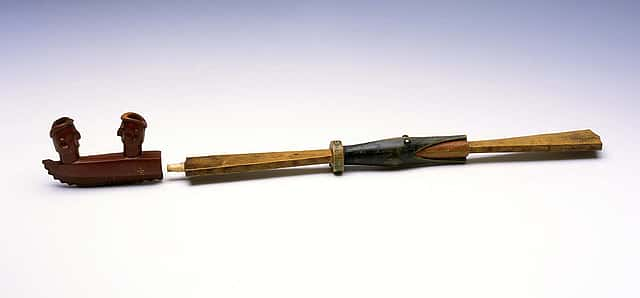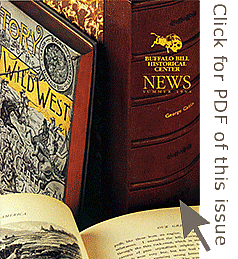
Ceremonial Pipes in the Plains Indian Museum – Points West Online
Originally published in Points West magazine
Summer 1994
Ceremonial Pipes in the Plains Indian Museum
By Emma I. Hansen
Curator Emerita, Plains Indian Museum
Before talking of holy things, we prepare ourselves by offerings…one will fill
his pipe and hand it to the other who will light it and offer it to the sky
and earth…they will smoke together. Then they will be ready to talk.
—Mato-Kuwapi (Chased by Bears), Santee-Yanktoni Dakota
Ceremonial pipes have played a pre-eminent role in the lives of native peoples of the Plains. As a means of prayer, pipes have been used to give thanks, to establish new relations and seal agreements, to mark important passages of ceremonial life, and to begin important expeditions. Considered one of the earliest forms of art among North American Indians, pipes continue to be made and to have a central importance in the religious lives of Plains Indian people.
Pipes were used in times of war and times of peace. A leader of a war expedition carried a pipe as a symbol of his leadership and his responsibilities for members of his party. During ceremonies, the pipe was smoked to ask for protection and success and to seek guidance on the expedition. Pipe ceremonies also took place to establish alliances between different tribal peoples and in councils before important deliberations were to take place. During the late 18th through 19th centuries, Euro-American traders and government officials often presented metal pipe tomahawks to Indian leaders as symbols of their authority.
Although pipe bowls were made from bone, pottery, steatite, shale, limestone and other materials, among people of the Plains catlinite has been most widely used. Quarried at a site in southwestern Minnesota now known as the Pipestone National Monument, this distinctive red stone is named for the artist George Catlin, who in 1836 was the first white man to illustrate the site. The name “catlinite” was given to the stone by the scientist Dr. Charles Thomas Jackson, who first analyzed the mineral using samples Catlin provided.

Although located in the territory of the Eastern Sioux, members of tribal groups from throughout the plains and prairies visited the site to quarry pipestone. According to Catlin’s record of Dakota tradition,
At an ancient time the Great Spirit, in the form of a large bird, stood upon the wall of rock and called all the tribes around him, and breaking out a piece of the red stone formed it into a pipe and smoked it, the smoke rolling out over the whole multitude. He then told his children that this red stone was their flesh, that they were made from it, that they must all smoke to him through it, that they must use it for nothing but pipes; and as it belonged alike to all the tribes, the ground was sacred, and no weapons must be used or brought upon it.
The Plains Indian Museum collection includes several outstanding examples of catlinite pipes, some with carved representations of people and animals and others with intricate lead inlay designs. The Lakota example illustrated may depict a tribal character known as “Iktomi,” the trickster, climbing the bowl of the pipe to escape a snake as it curls around the shaft.
The carved stems of the pipes were made of wood and decorated with quill and beadwork, as well as feathers. Men made their own pipes, and women dressed the stems. Pipe bags of hide with painted, beaded, and quilted designs also were made by women.
The collection also includes feathered calumets, among them a set from the Omaha, which was used in pipe ceremonies to establish friendly relations between tribes. The calumets, made of wood with the heads of mallard ducks and woodpeckers, and owl, duck and eagle feathers, were symbolic representations of pipes and were not smoked.

An exhibit of ceremonial pipes in the Plains Indian Museum was displayed during summer 1994. Because of recent controversies surrounding the display of pipes, we interviewed members of tribes from which these objects were collected about how to properly handle the pipes. Most suggested that pipes could be displayed if done with respect, and they specifically asked that the pipes and stems not be joined in the display. The joining of the pipe and stem signifies the beginning of a ceremony, and, therefore, is not appropriate for museum display.
The exhibit encouraged better understanding of the symbolism and use of pipes among Plains Indian people.
Post 037
Written By
Nancy McClure
Nancy now does Grants & Foundations Relations for the Center of the West's Development Department, but was formerly the Content Producer for the Center's Public Relations Department, where her work included writing and updating website content, publicizing events, copy editing, working with images, and producing the e-newsletter Western Wire. Her current job is seeking and applying for funding from government grants and private foundations. In her spare time, Nancy enjoys photography, reading, flower gardening, and playing the flute.


